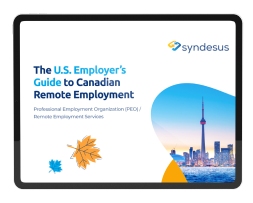US companies facing hurdles with the lengthy and expensive H-1B visa process have increasingly turned to Canada as a viable option for hiring and retaining tech talent. This is primarily due to Canada’s welcoming immigration laws, which are especially favorable for skilled tech workers, and its proximity to the US. It’s also more cost-effective, as, according to Bloomberg Law, “paying to relocate a worker to Toronto or Vancouver costs a fraction of what it would cost to replace them with a new employee.”
But beyond these advantages, if a US employer wishes to eventually bring that employee to the US, there are longer-term US immigration strategies that can be implemented against the backdrop of remote hiring in Canada.
In this article, we will explore some of these strategies and how they can benefit US companies, and their employees long-term.
Canadian immigration for tech workers: everything you need to know
A key strategy for hiring much-needed talent is to leverage other countries’ favorable immigration laws and pursue nearshore options; Canada offers just that with the Global Talent Stream program. The country’s vibrant tech industry and high quality of life make it an ideal place for tech professionals looking to relocate. Here’s everything you need to know about working and becoming a resident in Canada.
Global Talent Stream
The Global Talent Stream (GTS) is a quick way of hiring foreign workers for specialized jobs, and is currently one of the world’s fastest immigration pathways for tech workers. It offers a simple and efficient process to obtain permanent residency in Canada. Within two weeks, an employee can obtain authorization to work in Canada, and within a few weeks more, they can obtain a Canadian work visa, move to Canada, and start working. The GTS is particularly speedy for tech workers and offers a streamlined pathway to Canadian permanent residency and, eventually, citizenship.
Permanent Residency
After qualifying for the GTS, it’s possible to become eligible for Canadian permanent residence within one to two years. Once an employee has permanent residency status, they can receive most of the social benefits available to Canadian citizens and change employers freely. There are many benefits to becoming a resident of Canada including a lower cost of living, access to free healthcare, and a thriving economy.
Canadian Citizenship
Eligibility for citizenship in Canada is available within five years. This is much quicker than in many other countries, including the US, and can open many doors to individuals as dual citizens. It also enables employers to use a number of “boomerang strategies” to have that employee return to the US as they will now be Canadian citizens. This can speed things up in some cases or offer completely new immigration pathways.
The top three US immigration strategies that US companies can leverage for their Canadian tech workers
Becoming a Canadian citizen opens a lot of options, but if you need your employee to be based in the US or they wish to return, then here are some great strategies you can utilize.
H-1B visa without worrying about only having three “bites at the apple” with STEP OPT.
Instead of escaping the H-1B process entirely, the individual can simply keep applying while in Canada. Also known as global parking, a company can temporarily park their employee in Canada while they make the next steps towards reapplying for the H-1B.
If the employee becomes a Canadian citizen, then they may want to go down the H-1B route again. This will make the process significantly easier as Canadian citizens don’t require visa stamps from a consulate abroad.
EB-1C for employees who grow to become managers or executives
Designed for people with extraordinary abilities, the EB-1C allows multinational executives or managers to obtain permanent residency in the US. One benefit to an employee working remotely in Canada is to have the employee move into a senior position and gain the experience over time to qualify for the visa. The applicant must have been employed for at least one of the past three years by a foreign company with a qualifying relationship with a US company. This can include working with an employer of record (EOR), which acts as the legal employer of the employee in Canada, if your company doesn’t currently have an office in the country.
TN Visa for tech workers who become Canadian Citizens.
A TN visa is available to Canadian and Mexican citizens with a qualifying degree, work experience, and a job offer. This is a simple way to avoid the H-1B process as it allows those eligible to work temporarily anywhere in the US. The application is also much quicker than the H-1B as you can apply at an airport in Canada, at a port of entry on the ground, or online. This is undoubtedly one of the most straightforward immigration strategies to utilize if you have a Canadian tech worker in the US and don’t need them to be based in the US for more than three years.
Syndesus can help you hire tech workers in Canada
Syndesus provides an EOR solution that helps US companies that don’t have an office in Canada leverage Canada’s tech talent and favorable immigration laws for tech workers, whether those companies are small US startups or large corporations.
Hiring workers remotely in Canada through Syndesus means that the immigration, payroll, HR, tax, and other administrative processes are taken care of for you while you focus on expanding or retaining your talented workforce.
Reach out to us to learn more about how we can help you hire and retain talent remotely in Canada!




